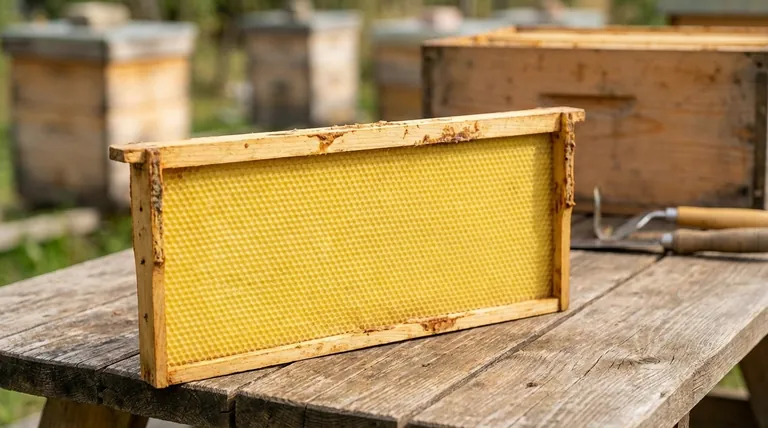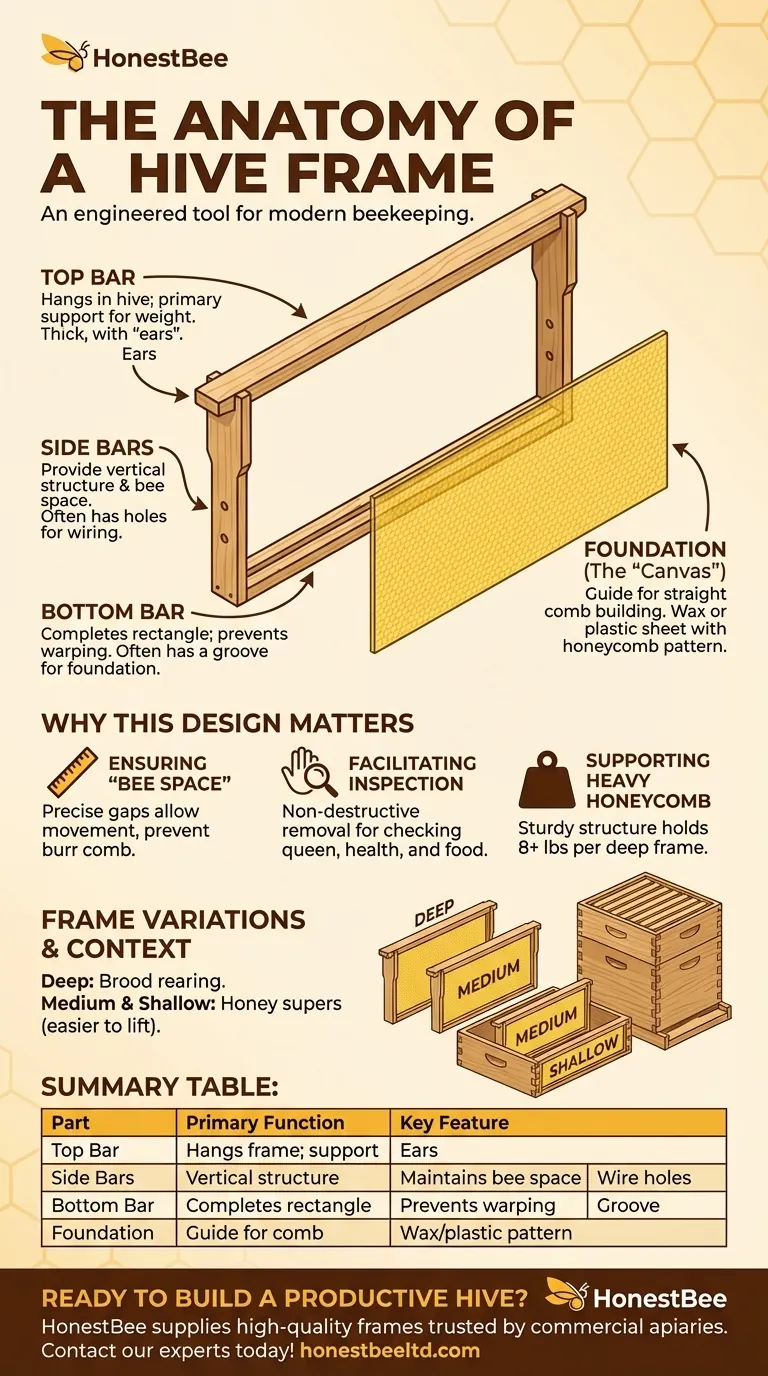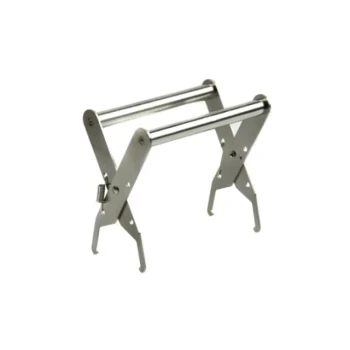At its core, a standard hive frame is a simple rectangular structure composed of three essential wooden parts. These are the top bar, which allows the frame to hang inside the hive box; the two side bars, which provide the vertical structure; and the bottom bar, which completes the rectangle and provides lower support for the honeycomb.
The hive frame is more than just a holder for honeycomb. It is an engineered tool that enables modern beekeeping, designed to respect the bees' natural instincts while giving the beekeeper crucial access for inspection, management, and honey harvesting.

The Anatomy of a Hive Frame
Each component of the frame is designed with a specific purpose, contributing to the overall function within the hive. Understanding these parts reveals the ingenuity of modern hive design.
The Top Bar
The top bar is the frame's primary support structure. It features two extended ends, often called "ears," that rest on a ledge inside the hive box, allowing the frame to hang securely.
This bar is typically the thickest part of the frame, built to bear the significant weight of honey, pollen, and brood without sagging over time.
The Side Bars
The two side bars provide the frame's vertical height and structural integrity. Their dimensions are critical for maintaining what is known as "bee space."
Many side bars include small, pre-drilled holes. These allow beekeepers to run wire through the frame, providing extra support for the wax foundation on which bees build their comb.
The Bottom Bar
The bottom bar completes the rectangular structure, preventing the side bars from warping. It provides a solid base for the comb.
Often, the bottom bar (and sometimes the top bar) will have a narrow groove cut into it. This groove is designed to securely hold a sheet of wax or plastic foundation in place.
The Foundation (The "Canvas")
While not part of the wooden frame itself, the foundation is a critical component that fits inside it. It is a thin sheet of wax or plastic embossed with the hexagonal pattern of honeycomb.
This foundation provides a guide, or "canvas," encouraging the bees to build straight, even comb that is easy for the beekeeper to inspect and manage.
Why This Design Matters
The modern hive frame, a key part of the Langstroth hive, was revolutionary because it allowed beekeepers to interact with the colony in a non-destructive way.
Ensuring "Bee Space"
The precise dimensions of the frame are designed to maintain a specific gap—the bee space—between each frame and between the frames and the hive walls.
If this space is correct, bees can move freely but are discouraged from building unwanted "burr comb" that would glue the frames together, making inspection impossible.
Facilitating Inspection
The ability to remove each frame individually is the cornerstone of modern beekeeping. It allows a beekeeper to check the queen's health, look for signs of disease, and assess the colony's food stores without destroying the bees' work.
Supporting Heavy Honeycomb
A single deep frame can weigh over 8 pounds when full of honey. The frame's sturdy, rectangular construction is engineered to support this immense weight, both inside the hive and during the extraction process.
Variations and Context
Not all frames are created equal. Their size and type are directly related to their purpose and the hive box they occupy.
Frame Size and Hive Boxes
Frames come in different standard depths to match their corresponding hive boxes.
Deep frames are used in the lower "brood boxes" where the queen lays her eggs. Medium and shallow frames are used in the upper "honey supers" because they are lighter and easier to lift when full of honey.
Foundation vs. Foundationless
Beekeepers can choose to use frames with a pre-made foundation or opt for "foundationless" frames. Foundationless beekeeping encourages bees to build their comb with natural cell sizes, though it requires more careful management to ensure the comb is built straight.
Making the Right Choice for Your Goal
The type of frame you use is determined by its intended function within the hive.
- If your primary focus is brood rearing: You will use deep frames in the bottom brood boxes to give the queen a large, unbroken area for laying eggs.
- If your primary focus is honey collection: You will use medium or shallow frames in the upper boxes (supers), as they are much easier to handle when heavy with honey.
- If you are just getting started: Ensure the frames you purchase match the size of your hive boxes (deep, medium, or shallow) to maintain proper bee space.
Ultimately, the hive frame is the fundamental interface between the beekeeper and the colony, turning a mysterious box of bees into a manageable and productive hive.
Summary Table:
| Part | Primary Function | Key Feature |
|---|---|---|
| Top Bar | Hangs the frame in the hive; primary support | Thick, with "ears" that rest on the hive ledge |
| Side Bars | Provide vertical structure and integrity | Maintains "bee space"; often has holes for wiring |
| Bottom Bar | Completes the rectangle; prevents warping | Often has a groove to hold the foundation |
| Foundation | A guide for bees to build straight comb | Wax or plastic sheet with a honeycomb pattern |
Ready to build a productive and manageable hive?
HONESTBEE supplies the high-quality hive frames and beekeeping equipment that commercial apiaries and distributors trust. Our durable frames are engineered to support heavy honeycomb and maintain proper bee space, ensuring your colonies thrive.
Contact our wholesale experts today to discuss your apiary's needs and get the right equipment for your operation.
Visual Guide

Related Products
- Assembled Wooden Bee Frames with Beeswax Foundation Ready to Use by HONESTBEE
- Plastic Bee Frame Beekeeping Hive Frames for Wholesale
- 7 x Auto Bee Flow Hive Frames Plastic Beekeeping Hive Box Supplies
- HONESTBEE Wired and Assembled Wooden Bee Frames Foundation for a Thriving Hive
- Heavy-Duty Stainless Steel Clip-On Frame Perch
People Also Ask
- Can old bee frames be reused? Weighing the Risks vs. Rewards for Your Hive
- What are some tips for setting up hive frames? Build a Strong Foundation for Your Hive
- How do wooden frames perform during honey extraction? Superior Rigidity for a Smoother Harvest
- What are the advantages of using wooden beehive frames? Natural, Sustainable, and Bee-Friendly
- When should I throw away my bee frame? A Guide to Hive Health & Frame Rotation



















